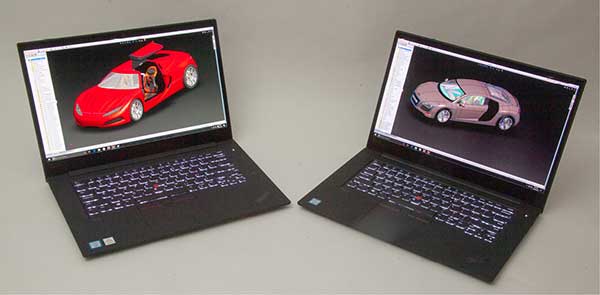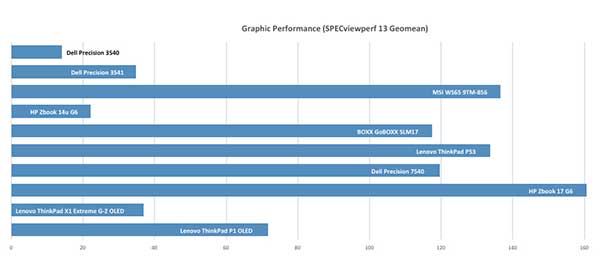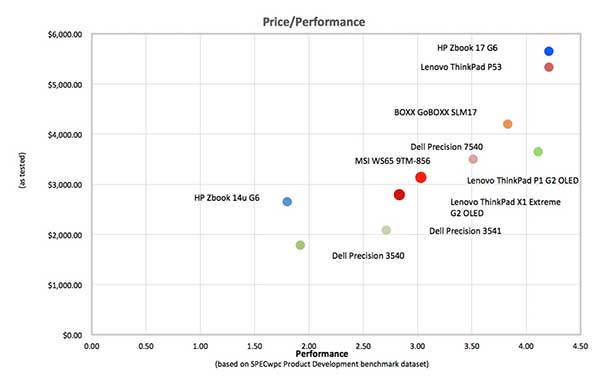A Perfectly Portable Pair: Lenovo P1, X1 ThinkPads
These latest P-series laptops provide a great combination of performance, portability and price.

The Lenovo ThinkPad P1 G2 and X1 Extreme G2 are nearly identical. Images courtesy of David Cohn.
Latest News
August 1, 2020
When we first reviewed the ThinkPad P1 (DE, March 2019), we deemed it to be the perfect combination of performance, portability and price. So, when Lenovo offered to send us the latest version of its powerful little mobile workstation, we jumped at the opportunity.
To sweeten the arrangement, in addition to the ThinkPad P1 G2, the company sent us the second generation of its ThinkPad X1 Extreme. Although not classified as a workstation (due to its consumer-grade graphics and lack of independent software vendor [ISV] certification), the X1 Extreme G2 would make for a fascinating comparison—particularly since both systems we received were equipped with discrete NVIDIA graphics processing units (GPUs) powering organic light-emitting diode displays.
Based on their outward appearance, there is no discernible difference between the two computers other than an X1 model ID in addition to the ThinkPad logo with its glowing red dot over the “i.”
Both come housed in a charcoal gray carbon fiber and magnesium alloy case with an updated carbon fiber weave that provides a subtle touch to the design. The systems measure 14.25x9.69x0.81-in. and weigh just 3.8 lbs., a few ounces less than the first-generation ThinkPad P1. Both also include identical 135-watt power supplies, which measure 4.9x3.0x0.9-in. and weigh a mere 0.9 lbs.
The ThinkPad P1 G2 base configuration has a starting price of $1,439 for a system with a 2.5GHz Intel Core i5-9400H quad-core processor, integrated Intel ultra high-definition (UHD) graphics, a full high-definition (1920x1080) in-plane switching anti-glare display with a rated brightness of 300 nits, 8GB of RAM, a 256GB PCIe solid-state drive (SSD), Wi-Fi and Windows 10 Home, backed by a one-year warranty.
The ThinkPad X1 Extreme G2 has a slightly higher starting price of $1,475 for a system with a 2.4GHz Intel Core i5-9300H quad-core processor and a discrete NVIDIA GeForce GTX 1650 GPU with 4GB of memory and 896 compute unified device architecture (CUDA) cores, but otherwise has the identical display, memory, storage, accessories, operating system and warranty.
But, of course, those are just the starting points.

Lots of Similarities
Raising the lid on either system reveals the same seamless spill-resistant keyboard with 84 mostly full-size keys as found on the original P1. Two levels of backlighting can be toggled by pressing the Fn key and spacebar. Although the systems lack a separate numeric keypad, the keyboard offers an excellent feel.
A round power button is located to the upper-right of the keyboard and a 4x2.75-in. touchpad with three buttons is centered below the spacebar. There is also the familiar red Lenovo pointing stick nestled between the G, H and B keys. The caps lock key has its own LED, as do the keys dedicated to the speakers, microphone and function lock. Both systems also include a fingerprint reader to the right of the keyboard.
A narrow bezel surrounds the display panel, yet still provides space above the panel for a 720p webcam, which now includes a privacy shutter. Lenovo offers a choice of four different display panels, including brighter (500 nits) full high-definition (1920x1080) and UHD (3840x2160) IPS anti-glare displays with Dolby Vision HDR.
Both of the Lenovo ThinkPad systems we received came equipped with 15.6-in. ultra high-definition (UHD) OLED touchscreen displays with Dolby Vision HDR that were stunning, with more vibrant colors and deeper blacks than we’ve ever seen in a mobile workstation. The OLED panel adds $345 to the cost of the P1 while increasing the X1 Extreme’s price by $380.
The similarities start to disappear, however, once you dive beneath the hood. On the ThinkPad X1 Extreme G2, Lenovo offers a choice of four additional CPUs, ranging from the same 2.5GHz Core i5-9400H in the base-model P1, to a 2.3GHz Core i9-9880H eight-core processor. Our evaluation unit came with an Intel Core i7-9850H, a six-core 2.6GHz Coffee Lake CPU (4.6GHz max turbo), which added $531 to the base price.
For the ThinkPad P1 G2, however, Lenovo also offers a Xeon CPU. Our evaluation unit included an Intel Xeon E-2276M six-core 2.8GHz processor (4.7GHz max turbo). Xeon-based P1 systems have a starting price of $2,029, $590 more than the base-model with an Intel Core processor, but also include an NVIDIA Quadro T1000 discrete GPU with 4GB of memory and 768 CUDA cores.
Although the GeForce GTX 1650 is the only graphics card available in the X1 Extreme, P1 customers can choose the NVIDIA Quadro T2000, a GPU with the same 4GB of memory and same Turing graphics chip as the T1000, but with 1024 CUDA cores, yielding faster graphic performance.
Some Significant Differences
Although the P1 and X1 Extreme offer similar memory configurations, the cost and options vary. Both can accommodate a maximum 64GB of 2666Mhz RAM. For our evaluation, Lenovo equipped the ThinkPad X1 with 32GB, installed as a pair of 16GB DDR4 memory modules, an option that added $455. But for the Xeon-powered ThinkPad P1, we received 32GB of error-correcting code memory, which added $310.
The amount of onboard storage also differs between the two systems. In addition to the 256GB SSD in the base model X1, Lenovo offers just two other choices: a 512GB drive and the 1TB PCIe NVMe M.2 drive in our evaluation unit, a $591 option.
For the ThinkPad P1 G2, however, there is a choice of SSDs up to 2TB and the P1 can be equipped with up to two M.2 drives, for a total of 4TB of onboard storage. And the 1TB drive in the P1 we received added just $205 to the total cost.
In addition, by upgrading the display in the ThinkPad P1 to the UHD OLED display, the webcam was automatically upgraded to one that includes an infrared camera, adding $20.
Both the P1 and X1 Extreme provide identical ports. The left side includes the power input, a pair of USB Type-C Thunderbolt 3 ports, HDMI, a headphone/microphone combo audio jack and a special jack for an RJ45 Ethernet extension connector. This connector is $35 extra when included with the X1 Extreme but only $20 when ordered as part of the P1 configuration.
The right side provides a security lock slot, a pair of USB 3.1 Type-A ports (including one that is always on when the system is plugged in), a SD card reader and a slot for an optional SD card reader (a $20 option).
Both systems include an Intel Wi-Fi 6 AX200 adapter with Bluetooth and come with the same four-cell Li-Polymer 80Whr battery with Lenovo’s Rapid Charge technology that can bring the system back up to 80% capacity in just an hour.
Battery life for the second-generation ThinkPad P1 was slightly improved—our evaluation unit lasted 7.25 hours on our battery run-down test. The ThinkPad X1 Extreme G2 fared a bit worse, shutting down after 6.75 hours. Both systems remained cool and nearly silent throughout our tests, even when under heavy compute loads.
Still Great Performance
We’ve come to expect Lenovo workstations to deliver excellent performance. Both systems matched or outperformed the first-generation P1 on most of our tests, delivering great results for a 15.6-in. thin, lightweight laptop.
On the SPECviewperf test, which focuses almost exclusively on graphic performance, the ThinkPad X1 Extreme G1 actually outperformed the ThinkPad P1 G2, often by a significant margin. Unfortunately, the X1’s GeForce graphics card meant that we could not run the SPECapc SolidWorks benchmark, because the GPU does not support the SolidWorks RealView feature, which is an integral part of the test.
On the demanding SPEC workstation benchmark, the ThinkPad P1 outperformed the X1 Extreme, thanks to its faster CPU and more robust GPU. But the ThinkPad X1 Extreme G2 averaged 44.1 seconds to complete our multi-threaded AutoCAD rendering test, compared to 49 seconds for the ThinkPad P1 G2.
Although both systems come with Windows 10 pre-installed, Windows 10 Professional in the P1 is included when you opt for a Xeon processor ($35 extra). On the X1, Windows 10 Pro is a $59 option.
Lenovo’s standard warranty only covers the system for one year, with depot carry-in service. Additional coverage is available at the time of purchase that can extend the warranty for up to five years.
Our as-tested price includes an additional $109 to extend the warranty to three years. Other warranty options include onsite repairs, premier support, accidental damage protection and battery replacement warranties.
As a workstation, the Lenovo ThinkPad P1 G2 is ISV-certified for a wide range of applications from Autodesk, Dassault Systèmes, PTC and Siemens. It has also passed military certification tests and quality checks to ensure it can perform in extreme conditions. The ThinkPad X1 Extreme G2 does not include these certifications.
As tested, our Lenovo ThinkPad X1 Extreme G2 priced out at $2,794, while the ThinkPad P1 G2 we received totaled $3,133.

As you can see in our price/performance and graphic performance charts, the extra money yields improved performance and peace of mind of knowing that the P1 is guaranteed to run even your most demanding applications. Either way, however, these two second-generation ThinkPads deliver plenty of performance in an attractive, portable package.
More Lenovo Coverage

Subscribe to our FREE magazine, FREE email newsletters or both!
Latest News
About the Author
David Cohn is a consultant and technical writer based in Bellingham, WA, and has been benchmarking PCs since 1984. He is a Contributing Editor to Digital Engineering, the former senior content manager at 4D Technologies, and the author of more than a dozen books. Email at [email protected] or visit his website at www.dscohn.com.
Follow DE






